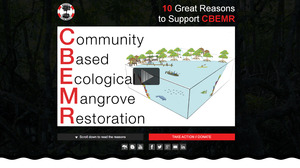|
Partnering with mangrove forest communities, grassroots NGOs, researchers and local governments to conserve and restore mangrove forests and related coastal ecosystems, while promoting community-based, sustainable management of coastal resources. |
|
|
The MAP News |
|
|
Action Alerts: |
SHARE MAP'S VISION
Please spread the word by sharing MAP's latest effort to raise awareness of mangroves and the role they play in global climate change mitigation CLICK HERE to watch short introductory video. Together we can work "at the roots of the sea". FEATURED STORY From the Executive Director - The rapidly expanding shrimp aquaculture industry poses one of the gravest threat to the world's remaining mangroves. Over a million hectares of lush mangrove forests have been cleared to make room for the artificial shrimp ponds of this boom and bust industry. This highly volatile enterprise has grown exponentially over the last 25 years, leaving devastating ruin in its wake. The failure of national governments to adequately regulate the shrimp industry, and the headlong rush of multilateral lending agencies to fund aquaculture development without meeting their own stated ecological and social criteria, are other important pieces to this unfortunate puzzle. The fate of remaining mangrove forests may now rest in the hands of the consumers from the wealthy nations that import these luxury shrimp products. Since a highly profitable and expanding market is the driving force behind the shrimp industry, a worldwide reduction in consumer demand for pond-raised shrimp is called for. Meanwhile, stricter local governmental regulations and enforcement protecting mangroves are necessary. Also, involvement of local communities in sustainably managing and protecting their coastal resource base, including the nearby mangrove forests, is essential. As well, pressure must be brought to bear on the purveyors of shrimp in the US, the EU and Japan, where large retail stores and restaurant chains such as Costco, Walmart and Red Lobster continue to promote shrimp over-consumption in order to further their profits at the expense of both the environment and coastal communities dependent upon the mangrove forests. And now, the spotlight on this industry must also fall upon the slave trade and human rights abuses connected with the production process as evidenced by this recent expose by the Guardian News! Editorial: I'm boycotting tropical prawns. But slavery demands a political solution By Felicity Lawrence The Guardian, Wednesday 18 June 2014 Should we boycott prawns? I have been asked that question repeatedly since the Guardian's investigation revealing the use of slaves in the chain that brings them from Thailand to our plates. The slavery we uncovered was no metaphor – we found trafficked migrants who had been bought and sold, and forced with extreme violence to work at sea for no pay for years. The fish they catch is used to make feed for intensive prawn production by the world's largest producer and supermarket supplier, CP Foods. Is it right to eat products that depend on such fundamental abuse of human rights? Consumer boycotts have been influential in bringing about change – against the horrors of apartheid, for instance – but on their own they have absolute limits. Just because slavery has been found in part of the food chain, we should not delude ourselves that changing the shopping basket will be enough. READ MORE More recent stories on human slave labor below Frozen food sector denies slave labour (June 19, 2014) Slave labour in fishery could cost Thailand dearly (June 14, 2014) Close net on slave trade (June 13, 2014) European retailers put pressure on Thai prawn supplier (June 13, 2014) CPF denies using fishy methods (June 12, 2014) View Guardian's video documentary about human trafficking in the shrimp feed business HERE ASIA Development Threatens Papuan Mangrove Forests PAPUA - Development in the lowland areas of Timika is fueling deforestation and threatening mangrove forests, raising the potential impact of climate change. “We see a serious threat to the lowland areas because many protected areas are already being converted into development areas,” said best management practice specialist with USAID Indonesia Forest of Climate Support (IFACS), Prianto Wibowo. Wibowo said the opening of mangrove forest areas to development would have an impact on peat-land forests as their damage would cause high levels of abrasion. He said his office would work closely with the National Land Agency (BPN), which has the power to issue certificates for mangrove forest clearance. “We will work closely with BPN so we can have information which locations already have certificates in order to determine steps to protect the mangrove forests,” he said. READ MORE New threat to Sundarban mangroves BANGLADESH - Bangladesh recently signed a Memorandum of Understanding (MoU) with China to set up a 1320 MW coal-based power plant in Patuakhali, a location also close to the Sundarbans. According to Chinese Ambassador Li Jun in Dhaka, who was present at the deal signing ceremony, the project will involve a cost of about $2 billion. This will be the second such project after the 1320MW Rampal power project in Bagerhat for which Bangladesh signed a contract with neighbouring India. Bangladeshi state-owned North West Power Generation Company Limited (NWPGCL) and Chinese state-owned China National Machinery Import Export Corporation (CMC) will build the power plant under a joint venture. Speaking on the occasion, Agriculture Minister Begum Matia Chowdhury said this is the part of the government’s plan to boost electricity generation by setting up coal-fired power plants. READ MORE Oil, Gas Committee blasts PM for her Rampal Power Plant remarks BANGLADESH – National Committee to Protect Oil, Gas, Mineral Resources, Power and Ports has blasted the prime minister for what it said misleading the nation on the plans to set up coal fired Rampal Thermal Power Plant close to the Sunderbans. In a statement to the press, Committee convener Sheikh Muhammad Shaheedullah and member secretary Anu Muhammad said that in her news conference on return from China she gave some wrong information and arguments as to why the government chose to set up the coal fired power plant so close to the Sunderbans. The information and arguments she gave were bound to mislead the people, they said. They said that the prime minister was utterly wrong in saying that those who were opposing the coal fire fired power plant never cared to visit the project site or collect its information. READ MORE Sand mining – dredging every last grain within a coastal protected area CAMBODIA - Last month (May 2014), villagers living in one of Cambodia’s coastal protected areas (Peam Krasaop Wildlife Sanctuary), were shocked to realize that sand mining was taking place within a kilometer of their fishing village, in the zone designated specifically for villagers to protect their environment. Armed with their maps and paper documents showing signatures from relevant authorities (including the Minister of Environment), the Village Management Committee and local Park Rangers showed the company their papers. Sand mining stopped for a few days: this, however, was a short-lived victory. Company officials, according to sources familiar with this case, met with the Chief of the provincial Department of Environment claiming that they had an appropriate license and operations resumed soon after this meeting. So, why is the provincial Chief ignoring policy that the Ministry of Environment, which he is a member of, has signed off on? And, who would sign a license to enable sand mining to take place within the community zone of a protected area? While it is unclear who has signed the company papers, someone is clearly supporting the sand mining from higher levels since the sand mining is in clear contravention of the Community-Based Protected Areas Management Sub-Decree. READ MORE Sri Lanka opens its largest aquaculture project in Chilaw SRI LANKA - Prawn farms were thriving in the vast marshes along the Puttalam lagoon when they first started in the mid-1980s and reached a climax in 1994 with owners making huge profits. However, with the 1994 elections some of these farms were attacked and supporters of the new government set up prawn farms along the buffer zones and even government reserves. Due to this haphazard creation of farms and with the emergence of the ‘White Spot’ disease, the total prawn industry collapsed and with this the massive rural economy that built up in that area (through this industry) too, crashed. Hope is now growing that this entire abandoned area could be transformed into productive aquaculture to rear different kinds of fish, particularly after Sri Lanka’s largest aquaculture project began in 2012 in Ambakandawila, Chilaw. READ MORE Green enforcers check the mangroves PHILLIPPINES - Restoring mangrove swamps is a valuable way of protecting coasts against storm damage. But it needs more than good intentions, as experience in the Philippines shows. The Philippines has invested in a new greening programme that includes reforestation through mangrove planting after the country was hit by supertyphoon Haiyan in 2013, but locals say there is not enough research and investment done in the initiative, as some of the initially planted seedlings bore infestations. At one of the Greening Program’s sites newly planted propogules (long single stems which the mangrove drops in order to reproduce) have been infested by barnacles. Considerable manpower has been used to clean the stems repeatedly but, as the committee points out, it would have been better spent planting in areas free from barnacles to begin with. READ MORE AMERICAS Estimated extinction of mangroves in Baja region tops 50% by 2025 MEXICO - The Gulf of California contains low levels of mangrove forests. By contrast, on the Pacific Ocean coast where it is located, mangroves were once abundant. In a study by the National Commission for the Knowledge and Use of Biodiversity (Conabio) satellite images of the ecosystems in the northwestern region of Mexico was compared over time. In the document, the agency reported that the annual rate of mangrove loss is 2.5 percent and the trend is expected to continue. Projections estimate that by 2025 more than half of remaining mangrove species will be lost. Of the 60 species of mangrove in the world, the Mexican coastline is home to only four varieties: Red (Rhizophora mangle), Black (Avicennia germinans), White (Laguncularia racemosa) and Button (Conocarpus erectus). READ MORE (en Espanol) Study looks at the situation mangrove beaches of Todos Santos MEXICO - A fragment of what is to be developed by investors in the real estate and tourism industry in Todos Santos, will be analyzed within the "Long-term monitoring of the structure of the mangrove community and environmental characterization in the states of Baja California, Baja California Sur and Sonora. " The project tendered by the National Biodiversity Commission (Conabio) was awarded to various research centers, including the Research Program in Marine Botany Autonomous University of Baja California Sur (UABCS).Despite studies by schools of education, extension information covering the Baja California peninsula of mangrove forests is still inaccurate and Sonora requires a full evaluation. READ MORE (en Espanol) EUROPE UN officials call for restoration of ecosystems to reduce climate change disasters SWITZERLAND – Marking the World Day to Combat Desertification, United Nations officials emphasized the importance of restoring degrading lands to avoid or soften the potentially disastrous impacts of climate change. “Land degradation, caused or exacerbated by climate change, is not only a danger to livelihoods, but also a threat to peace and stability,” Secretary-General Ban Ki-moon said in his message for the World Day, observed annually on 17 June. He noted that recovering land that is degrading will have multiple benefits. “We can avert the worst effects of climate change, produce more food and ease competition over resources. We can preserve vital ecosystem services, such as water retention, which protects us from floods or droughts. “And a comprehensive and large-scale approach to land recovery can create new jobs, business opportunities and livelihoods, allowing populations to not only survive, but thrive,” he stated. READ MORE LAST WORD MAP celebrates with children’s mangrove art contest  On June 5, 2014, MAP celebrated the World Environment Day. For the event, we organized an art contest at the Ban Sai Kuan School, gathering 26 students from 6 schools in the sub-district of Kao Mai Kaew, Trang province. Seven teachers from the six elementary schools and four people from the TAO (Sub-District Administrative Office) staff participated in the contest, including the TAO Chief Administrator, Mrs. Patcharin Thepkaew. The contest started with a short ceremony with principal of the Ban Sai Kuan School, Mr. Jamrongsak Seesamai, giving a speech and then MAP presented certificates to the teachers for their participation and involvement in mangrove protection. The rules were simple: two hours to draw the mangrove and its entire ecosystem. Every student participated with enthusiasm and produced great drawings. After, the jury, composed of MAP staff, teachers and the TAO chief, viewed the art pieces and selected the three best drawings. The prizes were three kits for drawing with colored pencils and pens. More over, every participants and every teacher received a water bottle in order to reduce plastic waste caused by disposal drinking water bottle which pollute the environment where ever humans go.  The morning finished with a shared lunch with teachers and TAO staff: an occasion to thank all the participants for their collaboration and involvement.
Thanks to our mangrove projects supporter, the Global Nature Fund, and to the TAO Chief, Mr. Peerapan Rangmuang for his collaboration. By: Delphine Gébelin, MAP Volunteer Intern ~ WE WELCOME YOUR LETTERS - If you’d like to have the last word on this or any other mangrove related topic, please send us your submission for upcoming newsletters. We’ll choose one per issue to have “the last word”. While we can’t promise to publish everyone’s letter, we do encourage anyone to post comments on our Blog at www. mangroveactionproject.blogspot.com BACK TO TOP Not yet a subscriber? Click here to subscribe. Please cut and paste these news alerts/ action alerts on to your own lists and contacts. Help us spread the word and further generate letters of concern, as this can make a big difference in helping to halt a wrongdoing or encourage correct action. |
| Mangrove Action Project | |
Search News Archive
Sunday, June 22, 2014
MAP News Issue 341 - June 21, 2014
Subscribe to:
Post Comments (Atom)
-
The community of adults and youth in Cayman Islands has come together recently to release a series of educational videos. Each is geared to...
-
By Alfredo Quarto, Program & Policy Director Co-founder, MAP There is a rather urgent situation concerning the bio-invasion of the Son...
-
By: Isabel Robinson, MAP Volunteer Intern Some months ago I decided to come to Thailand and do an internship in mangrove conservation, ...
MAP News Issue #596 = April 20, 2024
ENTRIES NOW OPEN! Mangrove Photography Awards 2024 10 Years Celebrating Mangroves GLOBAL - MAP has launched our 10th Mangrove Photograp...







No comments:
Post a Comment
Note: Only a member of this blog may post a comment.